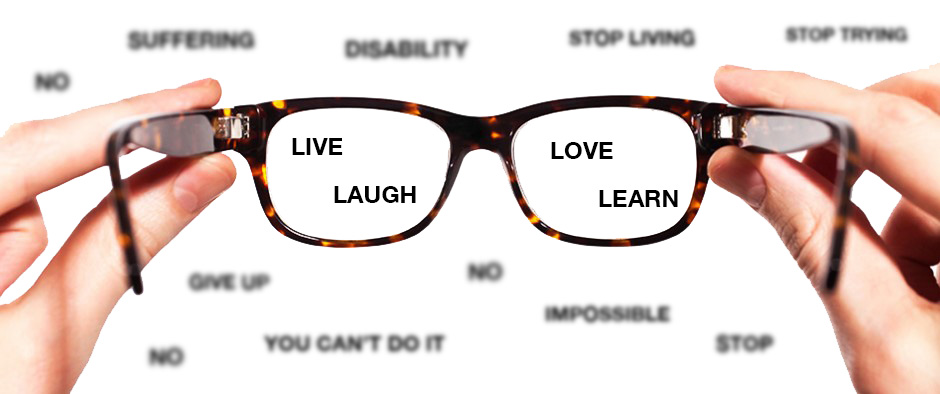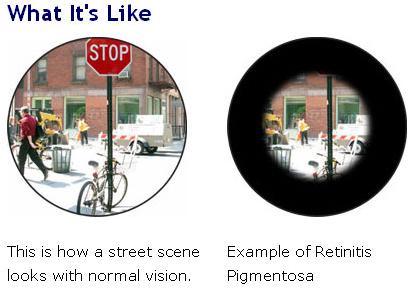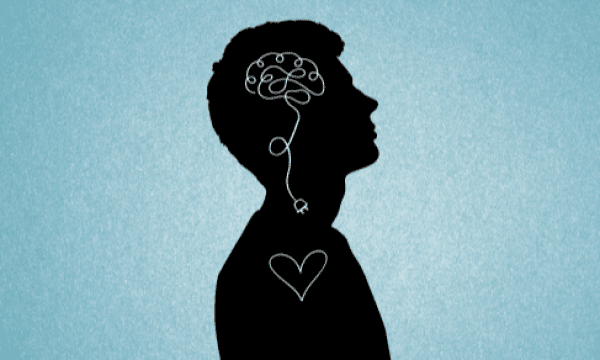
February 19th, 2011 is a day that I will never forget. As I patiently wait in my new Optometrist’s waiting room, I hope that my vision hasn’t changed. My biggest worry at the time was spending money on a new pair of glasses. My Optometrist calls me into his office. He is the sweetest old man I have ever met. He does all the usual tests and tells me that my vision hadn’t changed. I am thrilled, until he says that he has one more test to do.
I am required to tell him when I start noticing his pen, which he has on the side of my face. Do you know when I start to see the pen?! When it is literally in front of my face! This alarms my doctor, so he does a few more tests. They take pictures of my retina, and I have to do a visual field test, which might I add, is the most discouraging test I have ever had to take. My results display dark pigmentations, as if I have tons of beauty marks on my eyes. Dr. Pinksy tells me that I have a rare genetic eye disease called Retinitis Pigmentosa.
You’re probably wondering what RP is. Trust me I felt the same exact way. Basically RP occurs because the light-sensing retinal cells, called photoreceptors, are slowly damaged due to an inherited genetic mutation. We are all born with perfectly healthy eyes. However as we get older, our vision slowly diminishes due to many factors. There are two types of photoreceptors: rod cells and cone cells. Rod photoreceptors are responsible for peripheral vision and night vision. Cone photoreceptors are responsible for central vision and for seeing fine details and colours. In early RP, most patients notice difficulties with their night vision, because the mutations damage the rod cells first.
To help you understand what I see, imagine driving into a tunnel where you can only see straight down the middle, and nothing on either side. This is where we get the term “tunnel vision”. Luckily, I’m not at that point yet. However, I have lost a significant percentage of my peripheral and night vision. Fortunately, I’m still able to walk on my own and I can get around to places without help. On some lucky days I do not even realize I have it, until I bump into something, miss a step, or fail to notice someone standing next to me. In 2011, I was told that there was no treatment or cure for this disease. The worst part is that most patients by the age of 35-40 are legally blind.
I had just turned 21, was excited to live life, travel, and experience so many things, but now I’ve been given a time frame for how long I’ll be able to see the world around me. My whole life is changing right before my eyes. I was told that I am not allowed to drive, should refrain from being out when it is dark, and restrict certain foods and drinks in my diet. My parents raised me to be a very independent person. But now I have to be dependent on so many things and limit myself from what I can do.
Suddenly, many incidents from my childhood and teenage years now make sense. As a kid, my parents repeatedly would say “Shaini, watch where you’re going”, “Shaini, look at the ground to see what’s around you” or “Shaini, be careful”. This should have been a warning sign, but both my family and I just assumed that I was just not paying attention to my surroundings. When I was 16, my friends and I were out trick or treating, but I was struggling so much to find my way around. I needed help from my friend to guide me around the stairs and sidewalks. Back then I assumed that the neighborhood had horrible lighting. However, it wasn’t the neighborhood; it was my god damn eyes failing to help me see.
After my diasgnosis, I was discouraged beyond belief, to the point where I just ignored my problem as much as I could instead of dealing with it. My parents decided that we wouldn’t tell anyone about my condition, and at that time I didn’t disagree because I was pretending like RP didn’t exist. However, pretending that I didn’t have it didn’t stop my parents from being super protective. Before my diagnosis I was already practicing for Thalam 2011, with the Montreal Maniacs. I wasn’t going to give up dancing because of this condition. I convinced my parents to let me continue competing, and I am so happy I did. It was an experience that I will never forget, with friends and memories I will cherish for the rest of my life. Luckily, that wasn’t my last chance, as I competed with the Maniacs one more time. Then, just last year, I got the chance to compete at NACS with Tashan Performing Arts. As I look back, I’m glad that I didn’t let RP stop me from doing what I loved, because if I had stopped I wouldn’t have the memories I made throughout this journey.
When I wasn’t preparing for dance competitions, I was pretty much either at the doctors or at home, since my night blindness started to kick in. I had so much time on my hands, which helped me discover my passion for baking and cake decorating. This passion distracted me from the disease completely, because my vision didn’t get in the way or pull me back from baking and decorating. I was able to focus on this passion and start up Cakes & Shines in 2012, with the help of my family and friends who pushed me to do something that I loved.
At this point I was pretty much doing everything that I loved; working, dancing, cake decorating and traveling across the world, but I still felt like something wasn’t right. In the year 2013, the only people that knew what was really going on with me were my parents, siblings, and a few of my closest friends. To everyone else, nothing was wrong and I was completely normal. If I was out with friends for a birthday at a lounge, and there were stairs which I happened to “miss”, I would quickly play the drunken girl card, instead of the truth, because it just seemed easier. If I was out shopping and came across a staircase, and found myself struggling, I would blame it on a leg injury that didn’t exist.
Eventually, I finally got fed up keeping this secret and lying about who I am, and why I can or can’t do certain things. Growing up in a South Asian community, I feel that parents are very uneasy when the topic of a disability is brought up. Our parents’ generation isn’t comfortable admitting that their child isn’t perfect. My parents didn’t want people to judge me and put an unnecessary label for something that I had no control over. With time, I came to realize that the moment I stopped feeling sorry for my self, and accepted this journey that I was given, everything would fall into place. When I was first diagnosed, I used to repeatedly wonder, “Why me?” but now I am grateful that it happened. You guys must think I’m crazy right? I don’t think I would be the person I am today if it weren’t for RP!
The most important thing everyone should remember is that you shouldn’t let a disability define your life. Instead, work around it, find what works for you, and with the help of your support system nothing is impossible. I’ve been living my life to the best of my ability, but I wasn’t being honest to those around me. So this is my confession and the beginning of something new for me. Four years after being diagnosed I can proudly say that I am a changed woman, and I have grown and learned so much about myself and this world. Get out there, live, laugh, love, make mistakes, look back at those mistakes and laugh some more. I am hopeful that one day Dr. Keonekoop, will ask me, “Shaini, are you ready for treatment?” But until then I’m going to keep living my life, keep making memories and loving every moment, to the point where people are in disbelief that this girl named Shaini has a disability.





























